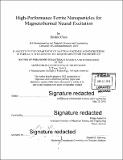High-performance ferrite nanoparticles for magnetothermal neural excitation
Author(s)
Chen, Ritchie
DownloadFull printable version (21.52Mb)
Other Contributors
Massachusetts Institute of Technology. Department of Materials Science and Engineering.
Advisor
Polina Anikeeva.
Terms of use
Metadata
Show full item recordAbstract
Wireless and cell-specific manipulation of neural circuits may enable non-invasive treatment of the diseased brain. Existing neuromodulation methodologies lack cellular specificity and resolution (electrical deep brain stimulation (DBS)) or rely on transgenes (optogenetics), and require surgical implantation of conduits to deliver electromagnetic stimuli into the targeted deep brain structure. Using nanoscale materials with tunable properties, this thesis seeks to develop minimally invasive tools to facilitate wireless dissection of neural circuits and provide solutions beyond current surgical and pharmacological interventions to treat diseases. We rely on non-invasive alternating magnetic fields as a signaling modality to actuate magnetic nanoparticles to dissipate heat via hysteretic losses. The transduced thermal stimuli can then trigger the depolarization of heat-sensitized cells, leading to phasic excitation of neurons in arbitrarily deep brain structures. We first develop a general dynamic hysteresis model that can qualitatively predict loss power trends for ferrite nanoparticles of variable size and chemical composition in the presence of clinically relevant field frequencies and amplitudes. We then identify synthesis strategies to produce highly-crystalline magnetic nanoparticles with enhanced biomedical performance over previously described methods. With this optimized materials set, we demonstrate wireless control of neural circuits in vitro and in vivo by magnetothermal stimulation.
Description
Thesis: Ph. D., Massachusetts Institute of Technology, Department of Materials Science and Engineering, 2016. Cataloged from PDF version of thesis. "[June 2016]" hand written on title page. Includes bibliographical references (pages 143-150).
Date issued
2016Department
Massachusetts Institute of Technology. Department of Materials Science and EngineeringPublisher
Massachusetts Institute of Technology
Keywords
Materials Science and Engineering.